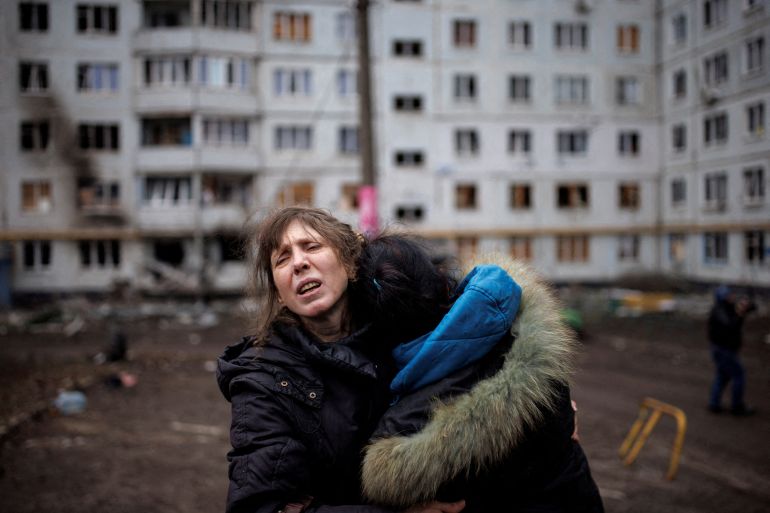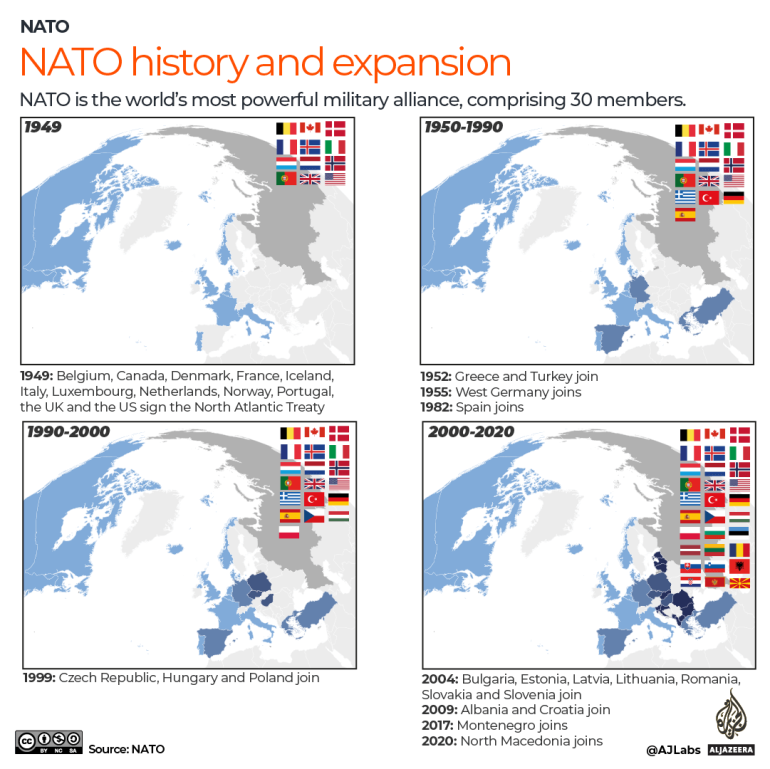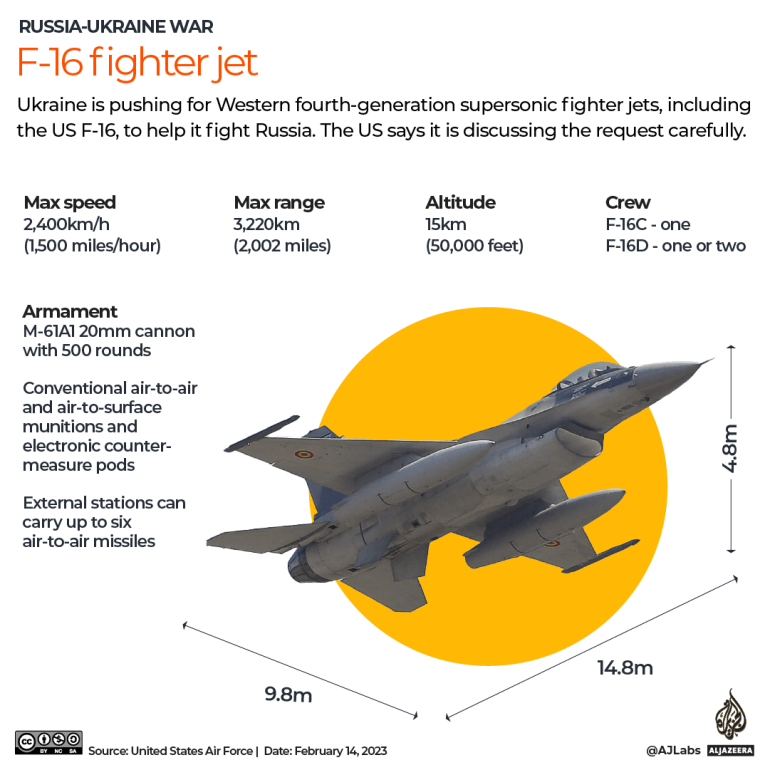A year of Russia’s war in Ukraine: Your simple guide
Ukraine says a renewed Russian offensive is under way following 12 months of bloodshed.

Almost a year has passed since Russian tanks rolled into Ukraine for a full-scale invasion that several world leaders had warned of.
The February 24 anniversary will bring a sense of mourning for Ukrainians. Many are grieving their relatives and all will remember the devastation that has rocked their country, as they reflect on what lies ahead.
Keep reading
list of 3 itemsWhy some EU countries in the east are still pro-Russia
Analysis: Ukraine’s new weapon will force a Russian shift
Thousands of Ukrainian civilians, including at least hundreds of children, and tens of thousands of troops on both sides have been killed. The exact tolls are hard to confirm, and most estimates are understood to be massively underestimated.
Millions of others were forced to flee from their homes in search of safety.
Looking ahead, there are fears of a wider conflict possibly involving nuclear warheads as relations between Russia and Ukraine’s allies in the West, which have worsened from lows as the war has raged, sink further.
Here’s what you need to know about the conflict as it enters a second year.
Why did the war start?
President Vladimir Putin launched Russia’s full-scale invasion in the early hours of February 24 last year.
In an address that morning, he described the offensive as a “special military operation”, saying the goal was to “demilitarise and de-Nazify Ukraine”.
He argued that Ukraine’s government had been subjecting Russian-speaking civilians in the eastern Donbas region to “genocide” since 2014.
That’s the year Russia annexed the Crimea peninsula and Moscow-backed separatists tried to break away from Kyiv’s control by seizing territory and setting up self-declared eastern states in the Donbas – the so-called Donetsk and Luhansk People’s Republic (DPR and LPR).
Most of the world still recognises Crimea, DPR and LPR as Ukrainian lands, but in the years since 2014, about 14,000 people died in a simmering conflict between Ukrainian government forces and rebels supported by Russia.
How many were killed on each side is hard to confirm, but few would agree with Putin’s use of the word “genocide”.
Putin’s “de-Nazify” comment – which has persisted throughout the war – was in reference to the Azov Batallion, a Ukrainian brigade rooted in far-right ideology, comprising volunteers who had fought against the separatists in the east. The group is now known as the Azov Regiment and some of its fighters have since rejected the far-right label.
On February 24, the Russian president also linked the invasion to the United States-led NATO transatlantic military alliance. He said Russia was intent on preventing NATO from expanding further eastwards and gaining a “military foothold” in Ukraine, which was part of the Soviet Union prior to its collapse in 1991.
Ukraine and its Western allies have rejected all of Russia’s rationales.
They say the war was unprovoked and aimed at seizing land and subjugating Ukraine. NATO has not moved to admit Ukraine as a member and says it is a purely defensive alliance.

Which nations support each side?
Ukraine’s allies are mostly in the West.
The US, United Kingdom, European Union, Japan and Australia, among others, have all backed Kyiv with billions of dollars worth of military and humanitarian aid.
Many NATO allies have been at the forefront of efforts to arm Kyiv with weaponry capable of repelling Russia’s forces.
Russia’s main backer is its neighbour and close ally, Belarus. Russia’s military used Belarusian territory as a launchpad for the invasion.
Moscow’s ex-Soviet Central Asian allies are treading a careful line. Over the year, most have called for peace and kept diplomatic ties with Russia, but analysts say a sense of worry is palpable as a war started by Russia, where Soviet power was established, grips a nation with a similar political history.
At the same time, many countries – such as China, India and Turkey – have avoided fully supporting either side.
How many people have been killed?
According to a February 13 United Nations report, at least 7,200 civilians, including hundreds of children, have been killed since Russia launched its invasion.
The true toll is likely to be considerably higher as continuing fighting hampers efforts to count the dead.
Tens of thousands of troops on both sides have also been killed, but again, the casualties are likely to be higher – according to Western officials, hundreds of thousands of soldiers have died.
Neither side provides reliable figures for their own war dead.
Outside Ukraine, the war has piled misery on millions of people suffering from acute food and energy crises. Ukraine and Russia are traditionally global exporters of food and the conflict has heavily disrupted supply chains.
Russia is also an exporter of energy – namely oil and gas – and has slashed supplies to the West in response to waves of sanctions, fuelling inflation and deepening cost-of-living crises in Europe, in particular.
What has happened so far?
At the outset of its invasion, Russia poured soldiers – an estimated 200,000 of them – into Ukraine from the north, east and south.
They captured vast swaths of territory and pressed towards the outskirts of Kyiv.
But Russian troops failed to seize the capital.
By the end of March, Ukrainian counterattacks had successfully pushed Russian units back in the north and south, retaking some areas and revealing atrocities carried out by occupation forces in places such as Bucha, a Kyiv suburb,
Forced into retreat, Moscow’s troops regrouped in Ukraine’s east and Putin recast the Kremlin’s goal as “the liberation of Donbas”.
Months of fighting along southern and eastern fronts followed. Moscow moved in late September to unilaterally annex four partly occupied territories – Donetsk, Luhansk, Kherson and Zaporizhia – a move widely denounced as a meaningless tactic.
Meanwhile, Ukrainian forces aided by Western arms supplies were busy staging sweeping counterattacks. By mid-November, the Ukrainians had recaptured the southern city of Kherson – the only regional capital Russian troops had seized since the outset of the war – a humiliating defeat for Moscow.
Since then, both sides have been locked in bloody battles for control of territory in the Donbas, which is made up of the Donetsk and Luhansk regions.
What might happen next?
Ukrainian officials believe Russia is beginning a renewed offensive to coincide with the first anniversary of the war.
They fear Moscow may deploy hundreds of thousands of conscripts it mobilised late last year in an attempt to turn the tide of the conflict in its favour, perhaps even staging another attempt to capture Kyiv.
Ukraine is preparing itself for new attacks, emboldened by enhanced Western military support in the shape of longer-range missiles and battle tanks.
President Volodymyr Zelenskyy says his government’s goal is not just to fend off offensives, but also to retake all Ukrainian territory captured by Russia, including Crimea.
Kyiv has pleaded with its Western allies for more military support to rid Ukraine of Russia’s invasion forces, with its most recent requests focused on F16 fighter jets.

Ben Wallace, the British foreign secretary, recently told The Sun newspaper that the world should “expect Russians to step up their indiscriminate targeting of civilian areas”, adding that Putin on the war anniversary “will lash out and kill more innocent people”.
And at the start of this month, Russian foreign minister Sergey Lavrov ominously warned in an interview with state media that Western events marking the anniversary “will not turn out to be the only events that will gain the world’s attention”.